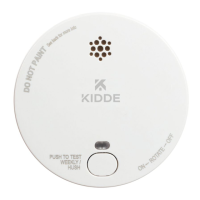13
7. Locations To Avoid
• In the garage. Products of combustion are present when you start your motor vehicle.
• Do not install smoke alarms on the walls if the room or hallway exceeds 10 m in both length and breadth, or exceeds
an area of 50 m
2
.
• Do not install alarms adjacent to, or directly above, heaters or air-conditioning vents.
• In very humid areas (above 90% RH, non-condensing), such as bathrooms and shower rooms. Do not install directly
above a sink, or near dishwashers or washing machines. Moisture or steam can cause nuisance alarms.
• Normal cooking may cause nuisance alarms. If a kitchen alarm is desired, it should be an interconnected heat alarm.
• Do not install within 2 m of heating or cooking appliances, measured horizontally.
• Do not install outside of the dimensional guidelines given in Figures 6-A, 6-C, and 6-D.
• In an area where the temperature may fall below 0 º C or rise above 40 º C such as garages and unnished attics.
• Do not install smoke alarms in dusty areas. Dust particles may cause nuisance alarm or failure to alarm.
• In insect-infested areas.
• Within 300 mm of a light tting, as electronic “noise” generated by the electronics may cause nuisance alarms.
• Do not install in an enclosed space (cupboard) or where the ventilation openings in the unit could be impeded by items
such as newspapers, table-cloths, furniture, curtains, etc.
• Do not install next to a door, window, extractor fan, ue, chimney, or any other area where high air ow
may occur or the unit may be directly exposed to weather.
• Do not install in locations that are difcult or dangerous to reach for testing or maintenance.
• Do not install DC (battery only) alarms on top of AC electrical junction boxes.
WARNING: To reduce the risk of re or electric shock, do not expose this product to rain or moisture.

